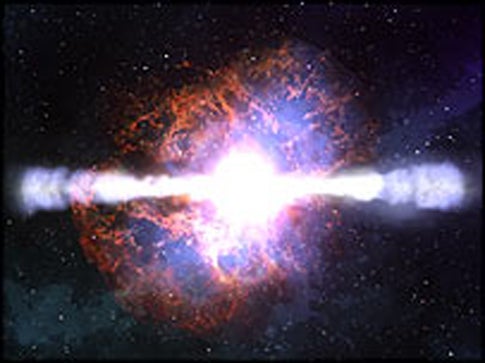Scientists are announcing this week their detection of a June 14 gamma-ray burst that probably signals a hitherto undetected type of cosmic explosion. The hybrid gamma-ray burst probably created a new black hole, but the details of how the explosion occurred are unclear.
In several companion articles appearing in the December 21 issue of the journal Nature, the researchers present observations of the burst leading them to suggest that the event was a new type of cosmic explosion.
“We’re still trying to figure out precisely what caused this event to come about, but its very mystery shows how much we still have to learn about the universe,” says Avishay Gal-Yam, an astronomer at the California Institute of Technology, and lead author of the paper on the Hubble Space Telescope’s observations of the event. “The detection certainly speaks well of NASA’s commitment to putting up satellites that can study such cataclysmic events as this one in detail.”
The burst was discovered by NASA’s Swift satellite and has since been studied with over a dozen telescopes, including the Hubble Space Telescope and telescopes at various ground-based observatories.
As with other gamma-ray bursts, this hybrid burst is likely signaling the birth of a new black hole. It is unclear, however, what kind of object or objects exploded or merged to create the black hole or, perhaps, something even more bizarre. The hybrid burst exhibits properties of the two known classes of gamma-ray bursts, yet also possesses features that cannot be explained.
“We have lots of data on this, dedicated lots of observation time, and we just can’t figure out what exploded,” said Neil Gehrels of NASA Goddard Space Flight Center in Greenbelt, Maryland, lead author of another of the Nature reports. “All the data seem to point to a new, but perhaps not so uncommon, kind of cosmic explosion.”
Gamma-ray bursts represent the most powerful known explosions in the universe. Yet they are random and fleeting, never to appear twice, and only in recent years has their nature been revealed.
Gamma-ray bursts fall into two categories, long and short. The long bursts are longer than two seconds and appear to be from the core collapse of massive stars forming a black hole. Most of these bursts come from the edge of the visible universe. The short bursts, under two seconds and often lasting just a few milliseconds, appear to be the merger of two neutron stars or a neutron star with a black hole, which subsequently create a new or bigger black hole.
The hybrid burst, called GRB 060614 after the date it was detected, was discovered in the constellation Indus. The burst lasted for 102 seconds, placing it soundly in long-burst territory. But the burst lacked the hallmark of a supernova, or star explosion, commonly seen shortly after long bursts. Also, the burst’s host galaxy has a low star-formation rate with few massive stars that could produce supernovae and long gamma-ray bursts.
“This was close enough to detect a supernova if it existed,” added Gal-Yam. “Even Hubble didn’t see anything.”
Certain properties of the burst concerning its brightness and the arrival time of photons of various energies, called the lag-luminosity relationship, suggest that burst behaved more like a short burst (from a merger) than a long burst. Yet no theoretical model of mergers can support a sustained release of gamma-ray energy for 102 seconds.
“This is brand new territory; we have no theories to guide us,” said Gehrels.
Scientists remain divided on whether this was a long short burst from a merger or a long burst from a star explosion with no supernova for whatever reason. Most conclude, however, that some new process must be at play: either the model of mergers creating second-long bursts needs a major overhaul, or the progenitor star from an explosion is intrinsically different from the kind that make supernovae.
“While we don’t yet know what GRB 060614 was, we have learned that the simple picture we had before, with long GRBs coming from supernova explosions and short GRBs from mergers of neutron stars, cannot be the whole story. This hybrid burst is telling us that we have at least one more mystery to solve,” concludes Gal-Yam.










